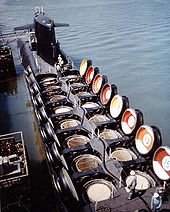- Ballistic missile submarine
-
A ballistic missile submarine is a submarine equipped to launch ballistic missiles (SLBMs).
Contents
Description
Ballistic missile submarines are larger than any other type of submarine, in order to accommodate SLBMs such as the Russian R-29 or the American Trident. Although some early models had to surface to launch their missiles, modern vessels typically launch while submerged at keel depths of usually less than 50 meters (164 feet).
Purpose
Ballistic missile submarines differ in purpose from attack submarines and cruise missile submarines; while attack submarines specialise in combat with other naval vessels (including enemy submarines and merchant shipping), and cruise missile submarines are designed to attack large warships and tactical targets on land, the primary mission of the ballistic missile is nuclear deterrence. Accordingly, the mission profile of a ballistic missile submarine concentrates on remaining undetected, rather than aggressively pursuing other vessels. Ballistic missile submarines are designed for stealth, to avoid detection at all costs. They use many sound-reducing design features, such as anechoic tiles on their hull surfaces, carefully designed propulsion systems, and machinery mounted on vibration-damping mounts.
Ballistic missile submarines equipped with nuclear warheads serve as the third leg of the nuclear triad. The invisibility and mobility of submarines offer both a reliable means of deterrence against an attack (by maintaining the threat of a second strike), and a surprise first-strike capability - particularly given the range of the weapons they carry.
Terminology
United States
SSBN is the United States Navy's hull classification symbol for a nuclear-powered, ballistic nuclear missile-carrying submarine.[1] The SS denotes a "submersible ship", the B denotes "ballistic missile," and the N denotes "nuclear powered." In US naval slang, ballistic missile submarines are called "boomers". They operate on a "Gold" and "Blue" two-crew concept. The current fleet of ballistic missile submarines in the United States Navy consists of Ohio class submarines.
United Kingdom
In Britain, they are also known as SSBNs. (Ballistic missile submarines are referred to as "boomers".) The two crews are called "port" and "starboard" crew. Britain's nuclear deterrent is the Vanguard SSBN, which replaced the Resolution class submarine. A new project is under way to replace the Vanguard class submarine, under the designation Trident replacement.
France
The French Navy commissioned her first ballistic missile submarines as SNLE, for Sous-marin Nucléaire Lanceur d'Engin (lit. "nuclear-powered device-launching submarines"). The term applies both to ballistic missile submarines in general (for instance "British SNLE" occurs [2]) and, more technically, as a specific classification of the Redoutable class. The more recent Triomphant class is referred to as SNLE-NG (Nouvelle Génération, "New Generation").
The two crews used to maximise the availability time of the ships are called 'blue' and 'red' crews.
Soviet Union
The Soviets called this type of ship RPKSN[3] which is translated as "Strategic Purpose Missile Cruiser Submarine". This designation was applied to the Typhoon class. Another designation used was PLARB[4] which translates as "Nuclear Submarine with Ballistic Missiles". This designation was applied to smaller submarines such as the Delta Class.
Active classes
 France
France
 People's Republic of China
People's Republic of China
- Type 092
- Type 094
 Russia
Russia
 United Kingdom
United Kingdom
 United States
United States
Classes under development
Undergoing sea trials
 India
India
- Arihant class submarine 1 is in trials 4 under development in Visakhapatnam shipyard[5][6]
 Russia
Russia
Planned
Retired classes
 /
/ SovietUnion / Russia
SovietUnion / Russia
- Zulu class (diesel powered)
- Golf class (diesel powered)
- Hotel class
- Hotel II class
- Yankee class
- Yankee II class
- Delta I class
- Delta II class
- George Washington class
- Ethan Allen class
- Lafayette class
- James Madison class
- Benjamin Franklin class
- These five classes are collectively referred to as "41 for Freedom".
References
- ^ "SECNAVINST 5030.8" (PDF). United States Navy. 21 November 2006. http://doni.daps.dla.mil/Directives/05000%20General%20Management%20Security%20and%20Safety%20Services/05-00%20General%20Admin%20and%20Management%20Support/5030.8.pdf. Retrieved 10 September 2008.
- ^ SNLE-NG Le Triomphant, netmarine.net
- ^ РПКСН Ракетный подводный крейсер стратегического назначения (Raketny Podvodnyy Kreiser Strategicheskogo Naznacheniya)
- ^ «ПЛАРБ» - подводная лодка атомная с баллистическими ракетами)
- ^ Nuclear submarine all set to enter waters
- ^ http://khabar.ibnlive.in.com/news/53480/1
- ^ Chang, Andrei (3 March 2008), Satellite Images Provide Insight Into Chinese Ballistic Missile Submarine Capabilities, NTI.org, archived from the original on 30 Aug 2008, http://replay.waybackmachine.org/20080830071754/http://www.nti.org/d_newswire/issues/2008/3/3/05a7f8b5-44e0-45f9-960d-42c6a6b54878.html
- ^ "Q&A: Trident replacement". BBC News. 11 November 2006. http://news.bbc.co.uk/2/hi/uk_news/politics/4805768.stm. Retrieved 2006-12-01.
- ^ "The Future of the United Kingdom’s Nuclear Deterrent". Ministry of Defence. 4 December 2006. http://www.mod.uk/NR/rdonlyres/AC00DD79-76D6-4FE3-91A1-6A56B03C092F/0/DefenceWhitePaper2006_Cm6994.pdf. Retrieved 2006-12-05.
- ^ Weinberger, Sharon Weinberger Sharon (11 May 2010). "Five Big-Ticket Pentagon Programs in the Cross Hairs". Aol news. AOL Inc.. http://www.aolnews.com/nation/article/five-big-ticket-pentagon-programs-in-the-cross-hairs/19471445. Retrieved 11 May 2010.
- ^ Chavanne, Bettina. "Gates Says U.S. Navy Plans Are Unaffordable". The McGraw-Hill Companies, Inc.. http://www.aviationweek.com/aw/generic/story_channel.jsp?channel=defense&id=news/asd/2010/05/04/01.xml&headline=Gates%20Says%20U.S.%20Navy%20Plans%20Are%20Unaffordable. Retrieved 12 May 2010.
- ^ Deep impact
External links
- Video showing various SSBNs in action.
SSBN classes in service People's Liberation Army Navy
People's Liberation Army Navy French Navy
French Navy Russian Navy
Russian Navy Royal Navy
Royal Navy United States NavyCategories:
United States NavyCategories:- Ballistic missile submarines
Wikimedia Foundation. 2010.





